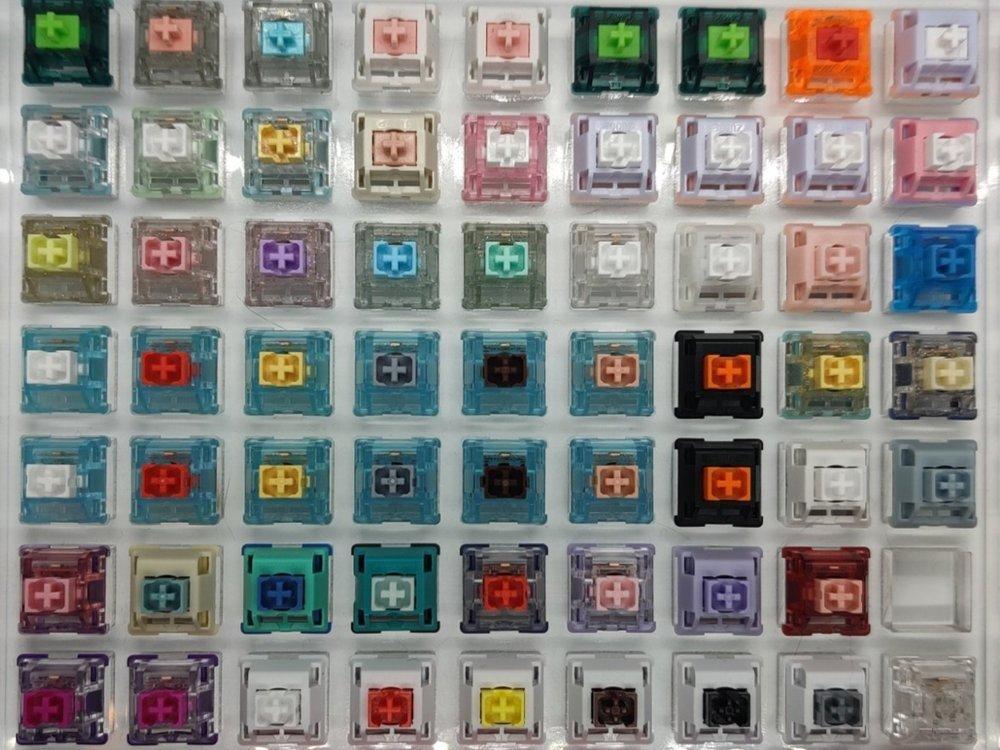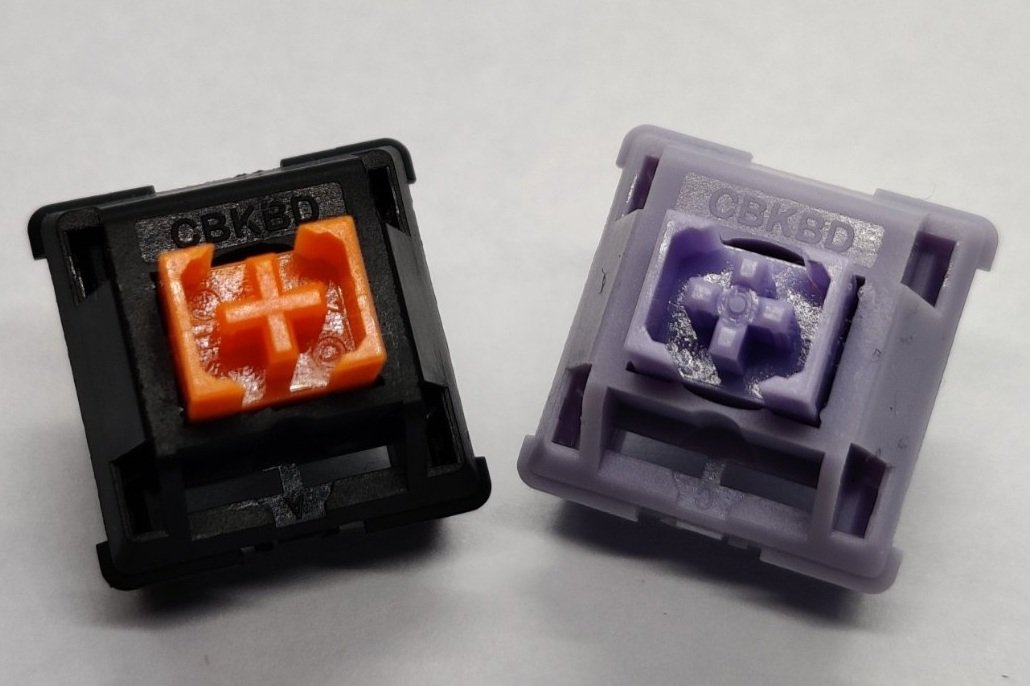
HaiMu Revisited
Quark Switches
Okay, so I don’t do reviews, but when I reached out to Flashquark with some questions about their new Quark switches they offered to send some over as long as I wrote them into an article. I figured that was a good way to force myself into writing again since I would feel guilty if I took too long. So without further delay, I shall shamelessly not review the Flashquark Quark switches.
I couldn’t talk about these switches without mentioning how long Flashquark has been around as he predates me by at least a couple of years I think, and is one of the few other vendors in the US selling single switches. I would know because some of my first 50 or so switches were from there, right after a basic Cherry and Kailh sample pack off Amazon. True to form, you can buy Quark switches as singles too, whether to try them out or to get exactly the number you need for your next keyboard.
First things first, Quark switches are Haimu linear switches, and as such can be expected to be pretty damn good switches, and they are. But, there’s more to these switches than meets the eye, and I promise I did get some cool background on them because what’s the point of a SwitchOddities writeup if I don’t do at least a little interviewing/investigating?

Speaking of what meets the eye…colors! Haimu did an awful job of color-matching Flashquark’s blue and orange logo for these switches. What’s that? They aren’t supposed to match the store logo at all? I guess I owe you an explanation for that then, good thing I got one from Flashquark. The purple and pink colors both have sciency reasons behind them. Flashquark has an interest in both biology and physics, which led to the selection of violet, the highest energy/shortest wavelength color the human eye can see. The magenta stem then comes from being a tertiary color, which he related to three quarks that make up the components of the nucleus of all known matter. He initially wanted to name the switches Hydrogen due to hydrogen atoms having only one proton (which would be made of three quarks) in the center, a perfect analog for the tertiary magenta in the center of the switch, but he was afraid he would then have to give this lengthy explanation for why the name and colors were used.

These are factory-lubed linear switches from Haimu and are of course exceptionally smooth. Now, the lube does feel a little heavy to me, similar to early Aflion switches like Tropical Water or Matcha Latte V1. But, it is specifically advertised as light lube, and can be seen to be pretty light when I opened a few switches, so that’s probably down to me using completely stock KTT Matchas on my daily board and just having a bad point of reference.
The Quark switches use Flashquark’s own 2-stage springs, in 62g and 68g variants, which was noted in their Reddit announcement but is actually not listed on the product page. This is interesting as it’s the first time I have heard of Haimu using third-party springs in a switch, and adds them to a very short list of manufacturers who have done so including JWK, and that’s it. Well, Gateron was open to third-party springs in the custom Linney switches, but to my knowledge, those never made it to production. (editor’s note: these are still the first, but no longer only switches from Haimu with custom springs, TX has custom switches either out or coming soon with their own springs, but I already had Quarks two days before I heard of the TX ones coming)
Custom Stem Molds
So, Haimu will use third-party/custom springs, but that’s not all. Alas/Sophia of CBKBD and runner of the Haimu Trash switches is also in the early steps of a nylon housing tactile switch. This new nylon tactile switch will come in a beautiful light purple and will be called Orchids. Simultaneously, Alas is also in talks with Haimu to get a custom stem mold made since all of their tactile switches use the same bump profile. This project is not nearly as far along, but they are targeting a Zealio V1 bump profile. Alas doesn’t have any more information about that project yet, but Haimu seems open to it. And of course, you can look forward to picking up each on SwitchOddities whenever they come out.

New Variations
Speaking of stems, we all know how much manufacturers love taking perfectly good conventions and breaking them, well Haimu wants to jump on that bandwagon next. When I wrote the first article on them, Haimu had observable differences between different, but unofficial, versions of their switches and housings. V1 housings had the HM-1XX mold marking on the bottom, and a 2XX marking on the top by the LED slot. These V1 switches only used standard, non-dustproof, half-silent stems, like KK Lightwave V2, and the Old Tom switches. Then we moved to dustproof stems, and two holes in the bottom housing for a V2 switch, and V2.5 brought a minor revision to the leaf shape. Now that we all remember those conventions, let’s introduce Zuoce DaiBai (which I previously called Zuoce Holy Panda) and the JKLP Holy Panda. These switches both have a non-dustproof, non-silent stem, which is already unique in light of Haimu’s previous releases. Though not content to buck one trend, Haimu is using these non-dustproof stems in V2.5 housings (V2 housing with updated leaf design), which is the only time I have seen non-dustproof stems in the housings with holes in the bottoms.

And they have even more housing variations, as they continue to confuse me for their own entertainment. Zuoce’s DaiBai linear switches had an unannounced housing change seemingly between their original GB and the more available version on most of AliExpress and KPREPUBLIC. The original bottom housing had a much lighter/less red-tinted shade of pink, and a blank space between the pins, whereas the updated version, is more salmon colored and has HaiMu molded into the housing between the pins.

V3 - Finally for Sale
And their newest revision which I called V3 in the last article, with the cross-braced hole in the bottom of the pole hole, has finally come out in production switches. The switch I showed off in the last article from Dukharo has not only been released but has already gotten a V2 variant that you can find at StupidBulletsTech. Continuing their confusing logic, Dukhharo switches came out in Pink and Green, so of course there are V2 Pink and Green switches, but there is also a V2 Plane switch, which to my knowledge never existed as a V1. But what fun would it be if we did things consistently? Similarly, Epomaker, who first showed off the Dukharo Green switch in one of their keyboards, has come out with their Budgerigar and Bluebird switches with these molds. Interestingly, the Flamingo switch that came out alongside Budgerigar still used the previous two-hole bottom housings.

New Ideas
What will they think of next? Huh - LED condensers? They are at a 45-degree angle and textured with a ton of tiny little pyramids? You know what, whatever you want HaiMu, I’m not going to stop you. The first switches we saw with these were the G-Square Rem and Ram silent switches, but there have been a couple more examples recently. I don’t have any for the collection yet, so I can’t speak from experience. Still, it must do a half-decent job since it looks like JWK/Durock released their own LED condenser switches with a suspiciously similar design versus every other condenser out there being smooth/round.

Okay, but surely they are out of new ideas now, leaf spring stem silencers, right angled contact leaves, holes in the housing, weird LED condensers, what else is there?

Switches….that smell like daisies. Haimu is really out here just throwing shit at the wall, and you know what? Fair enough, so far it’s all worked out fine so why not just keep trying stuff until something doesn’t work. Also, to be fair this one could be specifically the designer’s idea, I’m not sure, but I can assure you not every manufacturer would take that idea and run with it, so either way Haimu get’s at least partial credit for being open to it.
New Partners Bring More Attention in the West
It hasn’t been that long since I wrote the first article on Haimu, when they already somehow had nearly 50 different switches (counting spring wights/variants like Skyloong Glaciers and Keyfirst Bling) and now they must be well over 100. Hell, I have nearly 70 myself and I’m missing a significant amount of them. While I would love to take credit for that (hey, over 1,000 of you read that article) it is of course related to their evergrowing pile of partners. They started out strong with Skyloong/Epomaker who released quite a few switches and continues to work with them, but since then they have redoubled their partnership with Wuque, been picked up by Geon, and gotten custom switches made for Cannonkeys to really get their name into the Western market.
Speaking of Wuque, they are apparently now “Haimu’s official sole business agent outside Mainland China”. To be honest, I don’t know what that means. Geon is carrying what seem to be Haimu stock offerings, CBKBD still has active projects with them, and it would take a true idiot to cut ties with a vendor as large as Cannonkeys. For now, I’m just interpreting it as them being best friends.

Regardless, Haimu is a very interesting manufacturer. They have shown repeatedly that they are open to trying new ideas in their products, and not only that, but that their switches are consistently good. I’ve certainly enjoyed following them this far, and look forward to continuing to keep up with them and grow the collection ever larger. You can too, with over 25 Haimu Switches for sale on the store, and more likely coming soon. Plus, check out the vendors I mentioned in the article, including Flashquark, CBKBD, StupidBullets, KPrepublic, Wuque, Cannonkeys, Epomaker, and Geon if you want to find some switches I don’t have yet, or of course if you need a full set of one you’ve already tried out.
With that, I leave you with my current Haimu collection.

